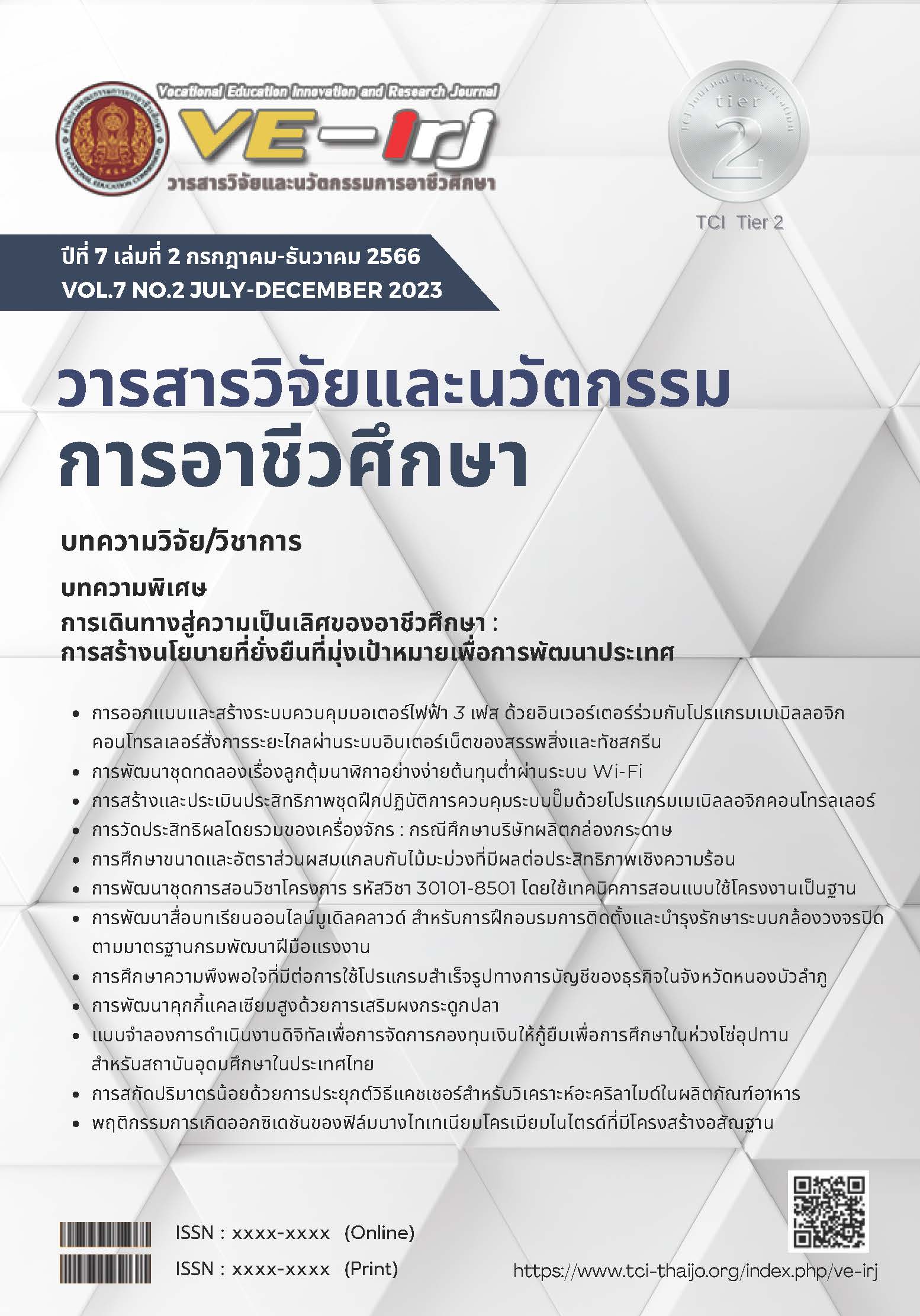การพัฒนาชุดทดลองเรื่องลูกตุ้มนาฬิกาอย่างง่ายต้นทุนต่ำผ่านระบบ Wi-Fi
Main Article Content
บทคัดย่อ
งานวิจัยนี้มีวัตถุประสงค์นี้เพื่อออกแบบสร้างชุดทดลองเรื่องลูกตุ้มนาฬิกาอย่างง่ายต้นทุนต่ำผ่านระบบ Wi-Fi ชุดทดลองที่สร้างขึ้นประกอบด้วย (1) ชุดลูกตุ้มนาฬิกาอย่างง่าย (2) เซนเซอร์จับการเคลื่อนที่ (3) ชุดสื่อสารไร้สาย ระบบ Wi-Fi (4) Arduino board และ (5) คอมพิวเตอร์ การทดลองเริ่มจากทำให้ลูกตุ้มนาฬิกาเคลื่อนที่แล้วจับเวลาการแกว่งด้วยเซนเซอร์จับการเคลื่อนที่ จากนั้นส่งข้อมูล (เวลา) ที่วัดได้ไปยัง Google Sheet ผ่านระบบ Wi-Fi เพื่อคำนวณค่าความเร่งเนื่องจากแรงโน้มถ่วงโลก (g) งานวิจัยนี้ใช้ความยาวของลูกตุ้มนาฬิกา 5 ค่า เพื่อวัดคาบการเคลื่อนที่ (T) โดยค่า g ที่ได้จากชุดทดลองที่สร้างขึ้นมีค่าเท่ากับ 9.87 m/s2. ชุดทดลองที่สร้างขึ้นมีราคาถูก มีขั้นตอนการทดลองที่ง่ายต่อความเข้าใจ เหมาะสำหรับใช้ในการเรียนวิชาฟิสิกส์พื้นฐาน
Article Details

อนุญาตภายใต้เงื่อนไข Creative Commons Attribution-NonCommercial-NoDerivatives 4.0 International License.
สงวนสิทธิ์ โดย สถาบันการอาชีวศึกษาภาคตะวันออกเฉียงเหนือ 1
306 หมู่ 5 ถนนมิตรภาพ หนองคาย-อุดรธานี ตำบลโพธิ์ชัย อำเภอเมืองหนองคาย จังหวัดหนองคาย 43000
โทร 0-4241-1445,0-4241-1447
ISSN : 3027-6861 (print) ISSN : 3027-687X (online)
เอกสารอ้างอิง
Darrah, M., Humbert, R., Finstein, J., Simon, M. and Hopkins, J. “Are Virtual Labs as Effective as Hands on Labs for Undergraduate Physics?. A Comparative Study at Two Major Universities”. Journal of Science Education and Technology. 23(6): 803–814, 2014.
Sari, U., Pektaş, H. M., Çelik, H. and Kirindi, T. “The Effects of Virtual and Computer Based Real Laboratory Applications on the Attitude Motivation and Graphic Skills of University Students”. International Journal of Innovation in Science and Mathematics Education. 27(1): 1–17, 2019.
Khambun, A. 2018. “The Development with Projectile Experimental Set by Automatic Angle”. Advanced Science. 18(1): 81-96. (in Thai)
Chantarank, M. and Suebkumpet, J. Development of Experimental Equipment for Observation the Freefall Action. Thesis, Rajabhat Mahasarakham University, 2018. (in Thai)
Buaprathoom, S. “A Set of Gravitational Acceleration Measurement Using Simple Microcontroller, DIY Sensors and Smartphone”. Journal of Research Unit on Science, Technology and Environment for Learning. 10(2): 288-299, 2019. (in Thai)
David, R. S., Priscilla, W. L. and Ronald, K. T. “Real Time Physics: Active Learning Labs Transforming the Introductory Laboratory”. European Journal of Physics. 28: S83–S94, 2007.
Amrani, D. and Paradis, P. “Use of Computer-Based Data Acquisition to Teach Physics Laboratories: Case Study-Simple Harmonic Motion”. Latin American Journal of Physics Education. 4: 511–514, 2010.
Wattanajung, P. and Boonphud, V. “Design and Development of Time Period and Gravitational Acceleration Measurement Equipment for Simple Pendulum Oscillation Apparatus”. Journal of Science and Technology. 5(1): 93 – 104, 2022. (in Thai)
Sangkaranee, K., and Katman, R. “The Operational Set of Simple Pendulum Equipment by Hall Sensor”. In: Proceedings of the 3th National Conference of Muban Chombueng Rajabhat University, 1 March 2015. Ratchaburi, Thailand, 2015. (in Thai)
Prirunrom, T. and Woradech, N. 2018. “The Measurement of Gravity in Thailand and Its Importance”. https://www.nimt.or.th/main/?p=21307 (Accessed 14 February 2023). (in Thai)
Boonphud, V. “Development of an Apparatus for Determination of Gravitational Acceleration with Digital Timer with IoT AutoPlay Program on a Smartphone for Physical Laboratory, Royal Thai Naval Academy”. 5(1). 158-169, 2022.
Sirathanakul, S. Development of Gravity Acceleration Measurement. Thesis, Rajamangala University of Technology Phra Nakhon, 2018. (in Thai)
Nuangnun, C. The Determination of Centripetal Force and the Gravitational Force by Using Conical Pendulum. Thesis, Rambhai Barni Rajabhat University, 2017. (in Thai)
Meemangkang, S. Economical Experimental Kit for Measuring the Gravitational Acceleration by Free Fall. Thesis, NakhonRatchasima Rajabhat University, 2010. (in Thai)
Vorahan, N., Voongdee, S. and Sangwaranatee, N. “A Study Acceleration due to Gravity from Experiment Set on Simple Pendulum by PICMicrocontroller”. the 7th Academic Meeting National and International Conference of Suan Sunandha Rajaphat University. 1(1). 2,966-2,977, 2016.
SensorsONE. 2021. Local gravity calculator, available at: https://sensorsone.com/local-gravity-calculator/#height. (Accessed 14 February 2023).
Muneeprom, J., Mani, M. and Chusiri, N. “Using Tracker Video Analysis Tool on Simple Pendulum Motion”. In: Proceedings of the 29th National Conference of Thaksin University, 9-10 May 2019. Songkhla, Thailand, 2019. (in Thai)
Sinacore, J. and Takai, H. “Measuring g Using a Magnetic Pendulum and Telephone Pickup”. The Physics Teacher. 48: 448–449, 2010.
Khairurrijal, K., Widiatmoko, E., Srigutomo, W. and Kurniasih, N. 2012. “Measurement of Gravitational acceleration using a computer microphone port”. Physics Education. 47: 709–714.
Yulkifli, Y., Afandi, Z. and Yohandri, Y. “Development of Gravity Acceleration Measurement using Simple Harmonic Motion Pendulum Method Based on Digital Technology and Photogate Sensor”. Materials Science and Engineering. 335: 1–8, 2018.
Pili, U. and Violanda, R. “Measurement of the Gravitational Acceleration using a Simple Pendulum Apparatus Ultrasonic Sensor and Arduino”. Physics Education. 54: 1–5, 2019.


